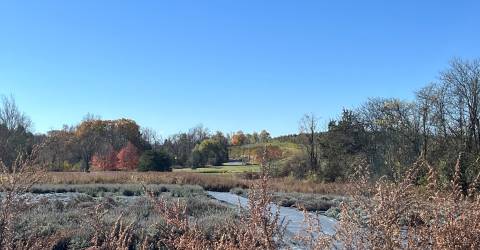Domestic Abuse and Food Insecurity Fuel One Another – Wiscasset Newspaper

Report on the Intersection of Domestic Abuse, Food Insecurity, and the Sustainable Development Goals
Introduction: A Framework for Analysis
This report examines the critical link between Intimate Partner Violence (IPV), also known as domestic abuse, and food insecurity. The analysis is framed within the context of the United Nations Sustainable Development Goals (SDGs), highlighting how these interconnected issues present significant barriers to achieving global targets for sustainability, equality, and well-being. The bi-directional relationship between abuse and hunger demonstrates that progress in one area is contingent upon addressing the other, demanding an integrated approach to social support and policy.
Key Challenges and Linkages to the SDGs
SDG 2 (Zero Hunger) and SDG 1 (No Poverty): The Cycle of Control and Deprivation
Domestic abuse is a direct driver of food insecurity and poverty, undermining the core principles of SDG 1 and SDG 2. Abusers frequently weaponize basic needs to exert control.
- Abusers strategically withhold money and other resources, directly limiting a survivor’s ability to purchase safe and healthy food.
- They may restrict access to groceries or misappropriate household funds, creating daily survival challenges and impeding a survivor’s ability to escape the abusive situation.
- When survivors leave, they often face an immediate financial crisis with few resources, making it difficult to feed themselves and their children. This aligns with data showing 34 million people in the U.S. lived in food-insecure households in 2021.
SDG 5 (Gender Equality) and SDG 10 (Reduced Inequalities): The Disproportionate Impact on Women
The intersection of IPV and food insecurity disproportionately affects women, revealing significant challenges to achieving SDG 5 and SDG 10.
- Nearly 25% of households headed by a single woman experience food insecurity, more than double the national average. This rate increases for women of color and those from marginalized communities.
- Research indicates that rigid gender norms are a contributing factor. Abusive partners often perceive a woman’s expectation of access to finances and decision-making as a direct challenge to their authority.
- A common tactic of abusers is to isolate their partners, undermining the social ties and support networks that can act as a safeguard against both violence and food insecurity.
- Studies show 52% of women seeking food assistance reported skipping meals themselves to ensure other household members could eat, underscoring a significant gender gap.
SDG 3 (Good Health and Well-being) and SDG 4 (Quality Education): The Wider Consequences of Hunger
The effects of food insecurity extend beyond hunger, creating severe and lasting damage that impedes progress on SDG 3 and SDG 4.
- Severe hunger impacts physical and mental health, emotional security, and the ability to work or think clearly. It is associated with long-term, irreversible health effects.
- For children, adequate nutrition is a prerequisite for learning and development. Food insecurity in households, as noted by the Annie E. Casey Foundation, means children may skip meals or go entire days without eating, compromising their ability to function and learn alongside their peers.
Strategic Interventions and Contributions to Sustainable Development
SDG 16 (Peace, Justice and Strong Institutions): The Role of Support Organizations
Organizations like New Hope Midcoast function as critical institutions that promote peace and justice at the community level, directly contributing to SDG 16. They provide essential support that disrupts the cycle of violence and poverty through targeted, empowering interventions.
- Safety and Resource Planning: Advocates work with survivors to develop safety plans that incorporate strategies for meeting basic needs, including food security, regardless of whether they choose to leave the abuser.
- Overcoming Logistical Barriers: For survivors in emergency shelters or hotels, organizations address key obstacles to food security by providing transportation to grocery stores and connecting them with food pantries that offer items preparable with minimal cooking facilities.
- Empowerment Through Provision: Enabling individuals to provide for their own basic needs is a foundational step in empowering them to move forward, reclaim autonomy, and rebuild their lives free from violence.
SDG 11 (Sustainable Cities and Communities): Building Resilient Support Networks
Achieving safe and resilient communities under SDG 11 requires robust, collaborative networks capable of supporting vulnerable populations. The work of domestic violence resource centers exemplifies this approach.
- Collaboration with a network of food banks, municipalities, hotels, and community members creates a viable support system for survivors.
- By coordinating with survivors, advocates help them make the safest and best decisions for their families, strengthening the community’s overall resilience.
- Recognizing that food access is a matter of independence and dignity is essential to building more just and sustainable communities where all members can thrive.
SDGs Addressed in the Article
- SDG 1: No Poverty – The article connects the inability to escape abuse with a lack of financial resources, a key dimension of poverty.
- SDG 2: Zero Hunger – The central theme is food insecurity, defined as limited access to safe, healthy food, which directly relates to ending hunger.
- SDG 3: Good Health and Well-being – The text highlights how severe hunger negatively impacts physical and mental health and emotional security.
- SDG 5: Gender Equality – The article explicitly discusses the link between domestic abuse (Intimate Partner Violence), rigid gender norms, and the disproportionate rate of food insecurity among women.
- SDG 16: Peace, Justice and Strong Institutions – The focus on domestic abuse and violence against women and children is a core component of this goal, which aims to reduce all forms of violence.
- SDG 17: Partnerships for the Goals – The article describes the collaborative efforts of New Hope Midcoast with other community organizations to support survivors.
Specific SDG Targets Identified
SDG 1: No Poverty
- Target 1.2: Reduce at least by half the proportion of men, women and children of all ages living in poverty. The article supports this by highlighting how domestic abuse survivors “often find themselves in crisis with few financial resources” and notes the increased vulnerability of households with incomes “less than $25,000.”
SDG 2: Zero Hunger
- Target 2.1: End hunger and ensure access by all people, in particular the poor and people in vulnerable situations… to safe, nutritious and sufficient food. The article directly addresses this by discussing how domestic abuse survivors and their children become vulnerable to food insecurity, with children having to “skip meals or even go a whole day without eating.”
- Target 2.2: End all forms of malnutrition. This is relevant as the article states that “School children need adequate nutrition in order to function and learn” and that severe hunger has “long-term, irreversible health effects,” which are consequences of malnutrition.
SDG 3: Good Health and Well-being
- Target 3.4: Promote mental health and well-being. The article connects hunger directly to well-being, stating that it “impacts people on many levels—physical and mental health, emotional security, ability to work, think clearly, and care for children.”
SDG 5: Gender Equality
- Target 5.1: End all forms of discrimination against all women and girls. The article points to this target by discussing how “rigid views of male and female roles” and challenges to “a traditional structure of gender and authority” contribute to the cycle of abuse and control.
- Target 5.2: Eliminate all forms of violence against all women and girls in the public and private spheres. The article’s entire focus on “Domestic abuse, sometimes called Intimate Partner Violence (IPV)” directly relates to this target.
SDG 16: Peace, Justice and Strong Institutions
- Target 16.1: Significantly reduce all forms of violence and related death rates everywhere. The work of organizations like New Hope Midcoast to support “victim-survivors of domestic abuse” is a direct effort to reduce the prevalence of violence as described in this target.
- Target 16.2: End abuse, exploitation… and all forms of violence against and torture of children. The article’s mention that “children from households experiencing food insecurity often have to skip meals” illustrates a form of neglect and suffering resulting from the domestic abuse environment.
SDG 17: Partnerships for the Goals
- Target 17.17: Encourage and promote effective public, public-private and civil society partnerships. The article provides a clear example of this, stating that “New Hope Midcoast collaborates with a network of organizations to develop viable plans for survivors that includes food banks, hotels, municipalities, and generous members of Midcoast Maine communities.”
Indicators for Measuring Progress
- Prevalence of food insecurity: The article provides a direct data point that can be used as an indicator: “34 million people lived in food-insecure households in 2021.” This aligns with official SDG indicators measuring the prevalence of food insecurity.
- Prevalence of food insecurity by gender and household composition: The article implies the need for disaggregated data by stating, “Nearly 25% of households headed by a single woman experience food insecurity, more than double the national average.” This serves as an indicator to measure vulnerability among specific groups.
- Proportion of population covered by social protection programs: The statistic that “12.3% of Maine households receive SNAP benefits” acts as a proxy indicator for reliance on and coverage by social safety nets designed to combat poverty and hunger.
- Prevalence of intimate partner violence: While no specific statistic on IPV prevalence is given, the article’s focus on the “bi-directional relationship” between food insecurity and IPV implies that tracking the rate of domestic abuse is a critical indicator for understanding and addressing the problem.
- Food deprivation as a coping mechanism: The finding that “fifty-two percent of women who applied for food assistance through U.S. Hunger routinely skipped meals” can be used as an indicator of severe food insecurity and the gendered impact of hunger.
Summary of SDGs, Targets, and Indicators
| SDGs | Targets | Indicators (Mentioned or Implied in the Article) |
|---|---|---|
| SDG 1: No Poverty | 1.2: Reduce poverty in all its dimensions. | Proportion of households with income less than $25,000; Percentage of households receiving SNAP benefits (12.3% in Maine). |
| SDG 2: Zero Hunger | 2.1: End hunger and ensure access to food for all. 2.2: End all forms of malnutrition. |
Number of people in food-insecure households (34 million in 2021); Percentage of households headed by single women experiencing food insecurity (nearly 25%); Percentage of women skipping meals (52% of applicants). |
| SDG 3: Good Health and Well-being | 3.4: Promote mental health and well-being. | Reported impacts of hunger on physical and mental health and emotional security. |
| SDG 5: Gender Equality | 5.1: End discrimination against women. 5.2: Eliminate all forms of violence against women. |
Prevalence of Intimate Partner Violence (IPV); Existence of rigid gender norms regarding household finances and roles. |
| SDG 16: Peace, Justice and Strong Institutions | 16.1: Reduce all forms of violence. 16.2: End abuse and violence against children. |
Prevalence of domestic abuse; Reports of children skipping meals due to household instability. |
| SDG 17: Partnerships for the Goals | 17.17: Encourage effective public, public-private and civil society partnerships. | Existence of collaborations between NGOs (New Hope Midcoast), food banks, municipalities, and other community organizations. |
Source: wiscassetnewspaper.com

What is Your Reaction?
 Like
0
Like
0
 Dislike
0
Dislike
0
 Love
0
Love
0
 Funny
0
Funny
0
 Angry
0
Angry
0
 Sad
0
Sad
0
 Wow
0
Wow
0



























;Resize=805#)








































![Significant progress made, but urgent action continues to be needed with 16 million people facing severe levels of acute food insecurity and 1.6 million children acutely malnourished in Bangladesh [EN/BN] – ReliefWeb](https://reliefweb.int/sites/default/files/styles/large/public/previews/31/9e/319ed978-b5f5-4b6d-9b3d-e530da6422ec.png?#)











